How the Stars Were Remembered...in 1960
I love combing through the Photoplay archives and I
found this in their 50th anniversary issue from December 1960: an
overview of some of the biggest names in Hollywood they’d covered since their
inception.
Here are some of my favourite entries.
GRETA GARBO: When 1926's The
Torrent introduced a Swedish girl of twenty to Hollywood, a legend was
born. From warm love dramas of the silents with John Gilbert, she went on to
make bigger news: ‘Garbo Talks in Anna Christie!... Garbo Laughs in Ninotchka!’
There are no more ‘I vant to be alone’ jokes now; her privacy is
respected as, still unmarried, she's seen around New York. Film's greatest
beauty!
MARY PICKFORD: She was the original
movie star! Before the sixteen-year-old Toronto girl faced cameras in 1909,
players weren't even identified. Then the rage for America's Sweetheart set up
the star system, began the big-salary boom. Coquette, her first talkie,
won her an Oscar in 1929. A 1914 PHOTOPLAY cover showed Mary with Owen Moore,
her husband before Douglas Fairbanks Sr. and Buddy Rogers.
GLORIA SWANSON: Saucily uptilted nose, flashing smile, special style—that's our Gloria, from her Mack Sennett debut to the present day. Born in Chicago, March 27, 1898, the 1920's star was often kidded as a "clothes-horse," but kept her sense of humor in comedies like Man-handled. Sunset Boulevard was a comeback. Husbands: Wally Beery, Herb Somborn, Marquis de la Coudraye, Michael Farmer, William Davey.
CLARA BOW: The redheaded ‘Brooklyn Bomb-shell’
turned a two-letter word into a synonym for sex appeal back in the rowdy Twenties.
Loaded with gaiety and vitality, ‘The It Girl’ danced through Dancing Mothers
and Wings, but when talkies came in, the party was over for a plump, unhappy
ex-flapper. Now fifty- five, Mrs. Rex Bell lives a secluded life, a semi-
invalid. There's an F Scott Fitzgerald finish.
HUMPHREY BOGART: Intense, ravaged features—matter-of-fact
voice with an odd lisp—these made a well-brought-up New Yorker an ideal
gangster. But he turned good guy in The Maltese Falcon, got romantic in Casablanca,
won an overdue Oscar in The African Queen. Ex- husband of Helen Menken, Margaret
Phillips and Mayo Methot, he found happiness with Lauren Bacall and two children
before he died in 1957.
JEAN ARTHUR: Her husky, sweet, funny voice
charmed everybody in great comedies like Mr. Deeds Goes to Town. But movies
were silent when this New Yorker (born October 17, 1908) first came to Hollywood.
Frank and friendly in her best-loved roles, Jean has always been quiet and
withdrawn as a person. Youthful marriage to Julian Ancker ended in annulment; divorced
from Frank Ross, she now lives in quiet retirement.
MARIE DRESSLER: She was a big woman, with
a broad face weathered and lined by life, mellowed rather than beaten. Marie was
born in Cobourg, Ontario, Canada, in 1869. Tillie's Punctured Romance hurled
her into the slap-stick whirl of 1914, but she was a nearly broke has-been in 1930
— when her derelict role in Anna Christie made her a star till death in 1934.
Her Oscar-winner: Min and Bill.
CHARLES CHAPLIN: Charlie, Chariot, The Little
Tramp—that's the way the world remembers him most fondly, as great comedian, great
actor. The Gold Rush alone outweighs politics and love-life. Ex-wives: Mildred
Harris, Lita Gray (mother of Sydney and Charles Jr.), Paulette Goddard. Seventy-two,
he lives in Switzerland with young wife Oona O'Neill (playwright Eugene's daughter)
and their seven children.
DEANNA DURBIN: The dreary middle of the 1930s
brightened when her fresh, rounded face flashed on the screen and her clear soprano
soared. Canadian by birth (Winnipeg, December 4, 1921), Deanna became a star at
fourteen with Three Smart Girls, but her career didn't last much beyond her
teens. Neither did her marriage to Vaughn Paul. Also divorced from Felix Jackson,
she's now Mrs. Charles David.
JOAN FONTAINE: You'd think a girl who looked as sensitive and shy as Joan would rouse any male's protective instincts. Instead, her heroes gave her a rough time (and a boost to stardom) in Rebecca and Suspicion. The latter movie also gave her a head start over sister Olivia in the Oscar race. Joan was born a de Havilland, October 22, 1917, in Tokyo. Ex-wife of Brian Aherne, Bill Dozier; parted from Collier Young.
IRENE DUNNE: The PTA's most popular chair-man,
the only women's-dub president that all the girls liked—that was always Irene's
type, whether she played it straight in Cimarron or made The Awful Truth
extra-funny with her indestructible dignity. Born in Louisville, December 20, 1904,
she has been the genuine lady off-screen, too, making Hollywood proud of her in
her long, happy marriage to Dr. Francis Griffin.
ERROL FLYNN: “Errol was never braver,”
jeered the critics when the rangy adventurer dead-panned as Captain Blood.
But his life, from its start in Tasmania in 1909 to its finish in 1959, was as gaudy
as his film derring-do, and his last performances had a true pathos. He married
three women (Lili Damita, Nora Eddington, Pat Wymore), liked the gals. Yet friends
hailed his honesty; said he himself was the easy mark.
JUDY GARLAND: The Wizard of Oz, becoming a holiday classic on TV, recalls the jolly-wistful young Judy who won everybody's heart in the late thirties. To reach adult triumphs like A Star Is Born, the ‘Born in a Trunk’ kid (Grand Rapids, January 10, 1923) had to battle the personal tragedy of illness and emotional upsets. Divorced from David Rose and Vincente Minnelli, she has husband Sid Luft as manager.
JANET GAYNOR: In 1928, a demure Philadelphia
girl became Oscar's first lady. The Academy statuette was too new to be nicknamed
then, and the auburn-haired Seventh Heaven star looked too young to be a
woman of twenty-two. Briefly married to Lydell Peck, Janet found with designer Adrian
a happiness that lasted till his death in 1959. Moviegoers saw her last in Bernardine,
as petite and appealing as ever.
HELEN HAYES: With her tiny frame and towering talent, she won an Oscar in her debut, The Sin of Madelon Claudet. Born in Washington, D. C., October 10, 1900, she had had a brilliant stage career before such memorable 1930's films as A Farewell to Arms and Arrowsmith. Helen and the late Charles MacArthur tragically lost their daughter, Mary; but adopted son James keeps up family tradition.
KATHARINE HEPBURN: The redhaired
Yankee rebel has lived down the kidding her high-toned voice used to draw. At fifty-one,
Katie is r’ally the great actress — r'ally, she is. It's a long way
from her Oscar-winning Morning Glory to The African Queen—The Philadelphia
Story to Summertime—Little Women to Suddenly, Last Summer!
She looks the spirited spinster, but is a divorcee (from Ogden Ludlow).
RITA HAYWORTH: The gorgeous redhead who
set the screen on fire in Gilda didn't look much like the shy, dark-haired
dancer who first arrived in Hollywood. Maybe that startling switch in personality
left inner confusion to account for Rita's rocky marital history: Ed Judson,
Orson Welles, the late Aly Khan, Dick Haymes. Mrs. James Hill, forty-two, has two
daughters: Rebecca Welles and Princess Yasmin (Aly's).
JEAN HARLOW: "Would you excuse me while I slip into something more comfortable?" murmured the platinum-blonde siren of Hell's Angels—already quite skimpily dressed. That meant fame. She became a delightful comedienne (remember Red Dust?) before her death in 1937, at twenty-six. Divorces from Charles McGrew and Hal Rosson and Paul Bern's suicide shadowed her life, didn't quell her spirit.
CAROLE LOMBARD: This golden lovely sparked 1930s light comedies with a unique dash and style and humor dating from her Sennett days. Nothing Sacred best reflected her gallant forthrightness. Divorced from William Powell (her My Man Godfrey co-star), she was married to Clark Gable when, at thirty-two, she died in a 1942 plane crash. She'd gone to her home state, Indiana, to help sale of war bonds.
BETTY GRABLE: In any World War II barracks,
there she was—a blonde in a white swimsuit, smiling coyly over her shoulder. Before
this St. Louis woman (born there December 18, 1916) became the Pin-Up Girl, she
was lost in campus comedies. But a Broadway hit made Hollywood appreciate her flair
for big musicals—as well as her celebrated legs. An unsuccessful marriage to
Jackie Codgan preceded match with Harry James.
LILLIAN GISH: No silent-movie actress ever
cried as eloquently as the delicate, golden-haired heroine of Broken Blossoms,
La Boheme. Born in Springfield, Ohio, in 1895, she was in her teens when the
great D. W. Griffith cast her in The Birth of a Nation. Surprisingly, after
movies began talking, Lillian serenely conquered the Broadway stage. Film roles
like The Unforgiven show authority. She has never married.
GINGER ROGERS: Something magic happened when she stepped out with Astaire, from their secondary spot in Flying Down to Rio to co- star in The Gay Divorcee. Ginger won an Oscar for the drama Kitty Foyle. (Anybody remember that 1940 epic?) Sleeker now and seemingly ageless (born July 16, 1911, in Missouri), she's shed husbands Jack Culpepper, Lew Ayres, Jack Briggs, Jacques Bergerac.
WILLIAM POWELL: No, he did not play the
title role in The Thin Man! (Edward Ellis did.) But the comedy-mystery and
its sequels set up debonair Bill and co-star Myrna Loy as top attractions. Born
in Pittsburgh, July 29, 1892, he was already a movie veteran, but in the 1920's
he'd usually been a sneaky villain (as in Beau Geste). Divorced from Eileen
Wilson, Carole Lombard; wed to Diana Lewis.
LUISE RAINER: Oscar was no friend to this
temperamental Viennese, who won the 1936 and 1937 Academy Awards (for The Great
Ziegfeld and The Good Earth)—and promptly went into eclipse! A fey sort
of girl, who wore a raggedy hairdo years before it became very fashionable, Luise
was at one time married to playwright Clifford Odets; lives quietly in retirement
as Mrs. Robert Knittel.
BARBARA STANWYCK: When some 1930s movie heel needed denouncing, nobody could rip off the big speech with more gusto than Barbara, the gallant gal from Brooklyn. Later movie hits, like Double Indemnity, proved her expert at playing the hard type. Personally a softie, she had general sympathy in her divorces from Frank Fay and Robert Taylor. She's refused to dye her hair, hide her age (fifty-three); has a TV show.
ROSALIND RUSSELL: Just say "career woman," and everybody sees Roz in square-shouldered suits and slouch hats of the late 1930s, bossing her world until some brave male (Cary Grant in His Girl Friday, for instance) subdues her. The bright Connecticut girl (born June 4, 1907) scores in the top feminine career, as Mrs. Fred Brisson. Broadway brought her back: Wonderful Town, Auntie Mame (also a film hit).
NORMA SHEARER: Her splendid profile, well-
groomed look, well-bred air fitted her for the First Lady role of the early 1930s.
Though she went slightly disreputable to win an Oscar for The Divorcee, it
was back to respectability in The Barretts of Wimpole Street, Smilin'
Through. Montreal-born (in 1905), Norma was a silent-movie ingenue when Irving
Thalberg married her. She's now Mrs. Martin Arrouge.
MAE WEST: ‘C’mup 'n' see me some time,’
she said in 1933's She Done Him Wrong. Her Gay Nineties ways were gay enough
to draw general censorial wrath on Hollywood's head. Ten years later, War II airmen
were calling their bulky lifejackets mae wests, in tribute to her buxom shape. Brooklyn's
her birthplace; the date, probably 1893. She also tried to hide marriage to Frank
Wallace, divorced in 1941.
__
From the Photoplay archives
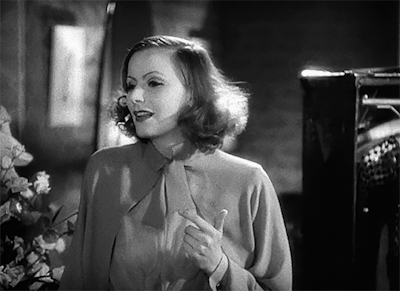
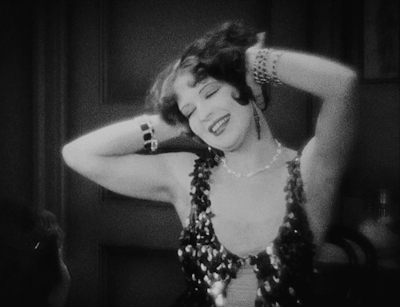
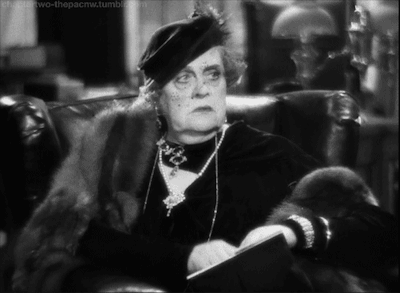
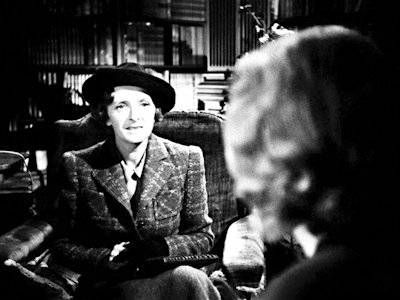

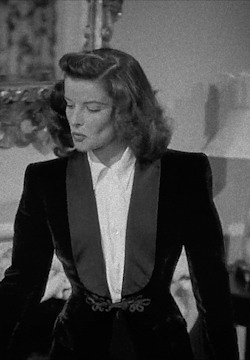

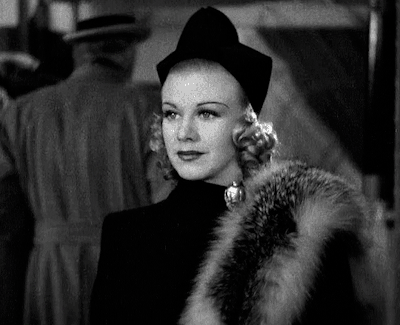

Comments
Post a Comment